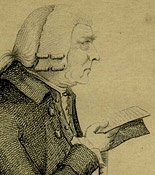Phrygia
Bryant, Jacob *
 Jacob Bryant (1715-1804) was an English antiquarian and mythologist, who completely denied that the Homeric account of the Trojan War had any historical value.(b) This infuriated the Romantic poet Lord George Byron, who denounced Bryant as a ‘blackguard’. All this took place decades before Schliemann began excavating at Hissarlik.
Jacob Bryant (1715-1804) was an English antiquarian and mythologist, who completely denied that the Homeric account of the Trojan War had any historical value.(b) This infuriated the Romantic poet Lord George Byron, who denounced Bryant as a ‘blackguard’. All this took place decades before Schliemann began excavating at Hissarlik.
Eberhard Zangger invoked [483.115] the work of Bryant to support his identification of Troy as Atlantis where Bryant refers to Dardanus as the founder of Ilium or Troy and declares the Dardanians to be Atlantians.
Although Bryant denied the reality of Troy, he was content to declare that the ‘Atlantians’ were descended from Ham, one of Noah’s sons and that they settled in Phrygia (part of modern Turkey) and Mauritania (North-West Africa). These comments can be found in one of his best known works, New System Or an Analysis of Ancient Mythology (1774 ed. Vol.1 p.387), which can now be read online[1033].(a)
(a) https://archive.org/details/analysisancientmyth01brya *
(b) Jacob Bryant – Wikipedia *
Hecatæus of Miletus
Hecatæus of Miletus (c. 550-476 BC) was one of the earliest Greek geographers. His view of the ‘world’ was that the then current concept of a landmass with the Mediterranean at its centre, encompassed by Europe and parts of Africa and Asia, all of which are surrounded by the Great Ocean or Okeanos. What is interesting about this model is that it does not show any island opposite the Strait of Gibraltar or even a hint of a ‘continent’ opposite as described by Plato. It should be noted that Hecatæus lived after Solon and also visited the priests of Egypt. As he did not make provision on his map for Atlantis it would suggest that he was not given the story or if he was, he was too sceptical to record it. In fact Hecatæus was inclined to dismiss much of Greek mythology as ‘ridiculous’.
which are surrounded by the Great Ocean or Okeanos. What is interesting about this model is that it does not show any island opposite the Strait of Gibraltar or even a hint of a ‘continent’ opposite as described by Plato. It should be noted that Hecatæus lived after Solon and also visited the priests of Egypt. As he did not make provision on his map for Atlantis it would suggest that he was not given the story or if he was, he was too sceptical to record it. In fact Hecatæus was inclined to dismiss much of Greek mythology as ‘ridiculous’.
Robin Lane Fox, the English classicist, wrote that the Hecateus located the Pillars of Heracles at Gibraltar[1403.208].
It is of interest that during his visit to Egypt, Hecateus was shown 345 statues by the priests at Thebes that represented as many generations of high priests. It is thought that he was not impressed by this claim. However, this reference has been employed as evidence for the great antiquity of the Egyptians and as firm support for Plato’s date of 9600 BC for the war with Atlantis.
Also worth noting is the fact that many decades later when Herodotus was shown the same collection of statues along with a similar claim of antiquity, the number recorded had dropped to 341!
Peter James has pointed out [047.75] that in the ancient world it was commonplace for nations to claim the greatest antiquity for their homeland, with Egypt, Phrygia and Babylonia being prominent contenders.
